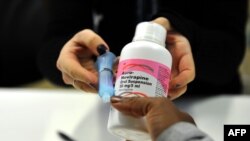Most young women who are at the highest risk of contracting the AIDS virus do not use drugs designed to prevent HIV infection, even when they're offered. That’s the conclusion of a new study that looked at so-called pre-exposure prophylaxis, or PrEP, in thousands of women in Africa.
Among those who take PrEP every day, the risk of HIV infection is greatly reduced — up to 92 percent lower compared with those who do not use pre-exposure prophylaxsis. The strategy is also not nearly as effective among people with HIV-positive partners who do not take it consistently.
The study of about 5,000 women in Uganda, South Africa and Zimbabwe looked at their use of the antiretroviral tablet Truvada or a generic version of the medication called tenofovir, and a vaginal gel made of tenofovir.
Three months into the study, blood results from nearly 650 women indicated a majority were not using their assigned product, whether it was the oral or topical medication.
Those who were least likely to take the drugs were women under age 25 — the ones at highest risk of contracting the deadly virus.
Despite the fact that most of them claimed enthusiastically that they used the medication regularly to protect themselves against infection by an HIV-positive husband or boyfriend, the blood samples indicated otherwise; only 25 percent to 30 percent of young women had detectable levels of tenofovir or Truvada in their systems.
“It was, I would say, a very, very unexpected, sobering, initially incredibly depressing result,” said Jeanne Marrazo, the study's lead author.
Marrazo, a professor of infectious diseases at the University of Washington in Seattle, noted that in addition to being the mainstay of PrEP, Truvada and tenofovir are used to treat HIV. Many of the women in the study felt stigmatized using an AIDS medication, she said.
“Many women said things like, ‘Well, you know, if I bring this product home and my boyfriend or my husband sees it on my counter, then they’re going automatically to think I have HIV and that’s it for me.’ Other women said, ‘I really can’t be seen with this because people are going to think I am at risk for HIV, and that’s just not OK," Marrazo said.
The research, published in The New England Journal of Medicine, found the overall incidence of new HIV infections was 5.7 percent, nearly twice what researchers expected.
But among younger women, up to 10 percent of participants became infected at some study sites in South Africa.
Marrazzo, calling her findings a game-changer, said she hoped they would lead to more effective strategies to prevent HIV transmission.
“It’s really changed the way prevention studies, I think, are going to be done," she said, "and it’s not just going to be for HIV, it’s going to be for anything that’s in very healthy people. Because really healthy people — you know how it is, you don’t really think bad things are going to happen to you until it’s too late, right?”
Another trial, involving a cervical ring embedded with antiviral drugs, is underway to see whether women are using the device correctly and consistently to prevent HIV infection.






